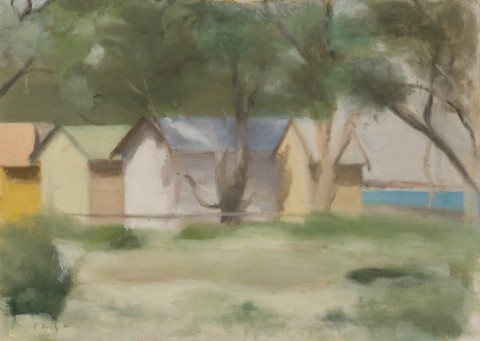BATHING BOXES, BEAUMARIS, 1928 - 30
CLARICE BECKETT
oil on canvas on compressed card
47.0 x 67.0 cm
signed lower left: C Beckett
bears inscription verso: 29
framer's label attached verso: John Thallon, Melbourne
Private collection, Melbourne
Private collection, Melbourne, thence by descent
Private collection, Melbourne, a gift from the above
Clarice Beckett’s enduring connection to the Bayside region of Port Phillip Bay was forged in early childhood. Although raised in Casterton in regional Victoria, her family often holidayed at Beaumaris, a coastal suburb to the south of the city of Melbourne.1 Beckett’s mother counted the artists Walter Withers and Ola Cohn among her friends and on their advice, she enrolled Clarice (and her sister Hilda) in National Gallery School in 1914, studying under Frederick McCubbin. Inspired later by a lecture by the artist-theorist Max Meldrum, Beckett joined his classes for nine months. Meldrum taught his own theory of ‘optical science’ aka Tonalism, which, as its name implies, revolved around building an image based on tonal values alone. Although she remained within the Meldrumite orbit throughout her subsequent career, Beckett’s paintings were truly a combination of the Gallery School’s academic teaching, Tonalism – and herself. As her colleague Elizabeth Colquhoun noted, her paintings were more ‘fragile’ than Meldrum’s; ‘It was a different kind of thing, but it was very truthful.’2
With her hand-made painting trolley in tow, Beckett would wander the same areas repetitively, always approaching a scene with a different ambition as to the mood she wished to capture. Indeed, when asked why she never felt the desire to travel more widely, she responded ‘I have only just got the hang of painting Beaumaris after all these years, why should I go somewhere else strange to paint?’3 From the earliest days of colony, this locale attracted pleasure seekers with the first public swimming baths dating from the 1840s. By the turn of the century, clusters of bathing boxes were built within the ti-tree scrub by private individuals, or to service the patrons of nearby guesthouses. In Bathing Boxes, Beaumaris, Clarice Beckett turns her gaze to one such group located in the cove of Watkins Bay, at the end of the street where the artist lived. Beckett’s distinctive style is immediately recognisable and, when seen collectively, her paintings provide an unsurpassed record of the changing landscape of the region. By the time Bathing Boxes, Beaumaris was likely painted, bathing huts could be found on all beaches in the area, sometimes two or three deep. The aspect of this work is nearly identical to that of Yachts in the bay, c.1933, a smaller painting in the collection of the National Gallery of Australia; and the Beckett family’s own hut was just outside the frame to the left. The artist’s compositional skill and mastery of colour allows the jumble of huts to be elegantly constrained by the greens of the grass and trees; and the single patch of blue water to the right emphatically anchors the whole design.
A related work, Bathing Boxes, Beaumaris, c.1932, depicts the same scene from the seaward side, and was offered by Deutscher and Hackett in April 2021. Ultimately, this idyllic view no longer remains as a huge storm in 1934 destroyed bathing boxes up and down the coast, most of which were not replaced. Bathing boxes Beaumaris, therefore, retains historic as well as aesthetic importance.
1. The family subsequently lived at ‘St Enoch’s’, Dalgetty St, Beaumaris, from 1919. The house burned down in 1945.
2. Elizabeth Colquhoun cited in Peers, J., More than just gumtrees: a personal, social and artistic history of the Melbourne Society of Women Painters and Sculptors, Dawn Revival Press, Melbourne, 1993, p. 197
3. Clarice Beckett, c.1928, cited in Hollinrake, R, Clarice Beckett: the artist and her circle, Macmillan, Melbourne, 1979, p. 21
ANDREW GAYNOR
